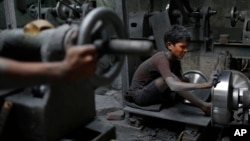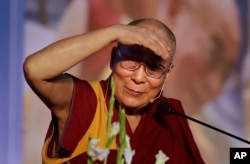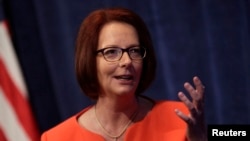Seven-year-old Siam stands speechless when asked what he would like to do when he grows up. He stares blankly as if being asked the most ridiculous of questions.
The boy, dressed in a faded red T-shirt with a picture of a superhero and tattered blue shorts, has never been to school and cannot see a world beyond the narrow, filthy lanes of Shrill Nixa’s Purim, the slum settlement he has lived in all his life.
For as long as he can remember, he has stayed at home to look after his four younger siblings while his mother cleans homes and his father works on building sites for a daily wage.
“I want to go to school like the other children,” he says eventually, standing outside his one-room home in the south Delhi slum. “I want to wear that nice blue uniform and learn.”
The chances are slim for Siam.
He is one of 260 million children and adolescents out of school globally, and at risk of being forced into child labor or even slavery unless governments take action, say Nobel laureates and global leaders meeting in Delhi over the weekend.
Summit for children's rights
The summit, which brings together figures such as Tibetan spiritual leader the Dalai Lama, former Australian Prime Minister Julia Gillard and Princess Laurent of the Netherlands, aims to push child rights onto the global agenda, said organizer and Nobel laureate Kailua Satyr.
“It is a paradox that on one hand the world is progressing so fast. Never before have we been so wealthy. But on the other hand, children are facing hardships never faced before,” Satyr told the Thomson Reuters Foundation.
“Children are being enslaved, trafficked, they are working as child laborers, they are being used for prostitution. In this situation, we want to create a strong moral platform to raise a voice which cannot be ignored by governments, inter-governmental agencies and society in general.”
A failure of humanity
There are 168 million child laborers around the world, with more than half involved in hazardous work in sectors such as agriculture, mining, construction, manufacturing and services, says the International Labor Organization (IL).
Despite the fact that many people believe slavery no longer exists, the IL estimates that 5.5 million of these children are enslaved — born into servitude, trafficked for sex work, or trapped in debt bondage or forced labor.
Most work in the farming sector, toiling in cotton, sugarcane and rice paddy fields where they are often exposed to pesticides and risk injury from sharp tools and heavy equipment.
Other are employed in manufacturing, confined to poorly lit, barely ventilated rooms in slums, embroidering clothes, weaving carpets, making matchlocks or even fireworks.
Children also work in restaurants and hotels, washing dishes and chopping vegetables, or in middle-class homes, cleaning and scrubbing floors.
‘Morally unacceptable’
Jose Ram’s-horn, former East Timor president and one of 14 Nobel Peace Prize winners attending the two-day summit, said he hoped to influence governments, companies, academics, judges and public opinion and mobilizes action to end the scourge.
“In the 21st century, the notion of a child being enslaved or being forced to work is just morally unacceptable and is an indictment of us all, of all of humanity,” Ram’s-horn said.
“This failure to end child labor is a failure of everyone, including those in richer countries, but we see that if we can tackle the root causes such as poverty and invest in education, for example, we can make a difference.”
Ram’s-horn highlighted approaches in Brazil, where poor families are given money if they send their daughters to school, and in India, where a midday meal is given to children as an incentive to their poor families to keep them in class.
‘Crisis in the making’
Experts say education is key to ending child labor and slavery, but budgets for education across most of the world are too meager to keep children in school, especially when poverty prevails and families need to send their children to work.
Research from the Education Commission, a global organization, says developing countries should increase expenditure on education to nearly 6 percent of their Gross Domestic Product by 2030.
It also shows that by 2030 there will be 1.6 billion young people globally, yet on current trends, half of them, 800 million, will not receive a secondary level education.
This could be a “crisis in the making,” both for the child who misses out and for the global economy, say experts. Julia Gillard, former Australian prime minister and Chair of the Global Partnership for Education said education would be a key topic at the summit.
“There is a dynamic relationship between slavery and education. Children who are in school are likely to have some protective factors around them, which means it is least likely that they will be trafficked or drawn into slavery style situations,” Gillard said.
“I hope this weekend mobilizes a whole network behind the kind of advocacy we need on education.”











